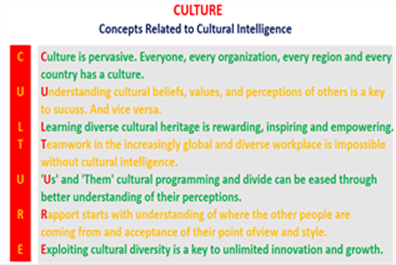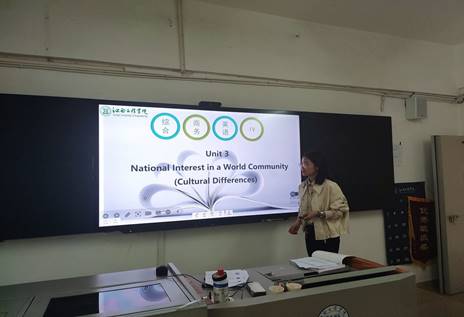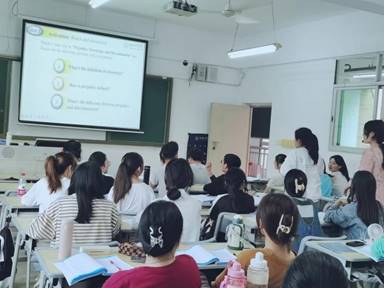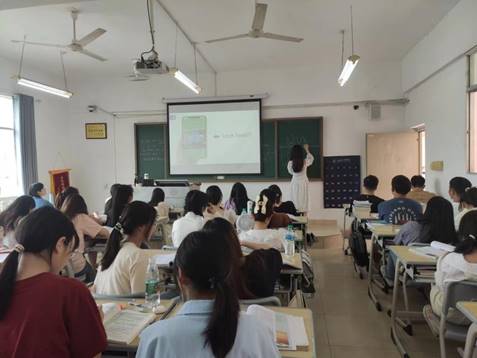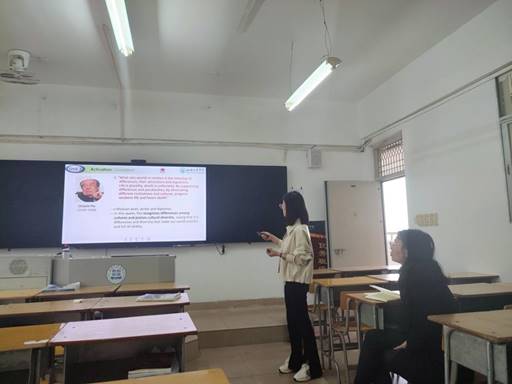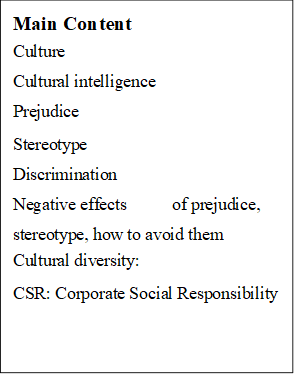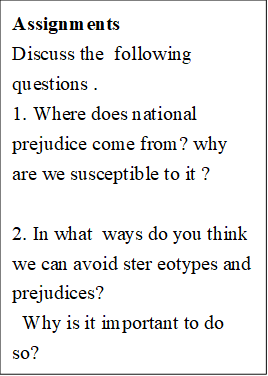【课程思政示范课】《综合商务英语Ⅳ》教学设计
Unit 3
National Interest in a World Community
(Cultural Differences)
| 授课题目 | Unit 3 National Interest in a World Community(Cultural Differences) | ||||||||||||||||||||||
| 教学目的 与 要 求 | After this unit, students are expected to : 1. Understand the main idea and structure of the text 2. Read critically and evaluate the development of arguments of the text 3. Grasp key words, phrases and sentences 4. Master writing strategy: parallelism 5. Know and avoid cultural prejudice and stereotype and be a global citizen 6. Identify the concept of Human Community with a Shared Future. | ||||||||||||||||||||||
| 教学重点 | 1.Understand the main idea and structure of the text 2.Read critically and evaluate the development of arguments of the text 3.Grasp key words, phrases and sentences | ||||||||||||||||||||||
| 教学难点 | 1.Know and avoid cultural prejudice and stereotype and be a global citizen 2.Identify the concept of Human Community with a Shared Future. | ||||||||||||||||||||||
| 教学方法 | 讨论法,任务型教学法,启发法 | ||||||||||||||||||||||
| 教学环节 | 复习回顾,新课导入,主旨内容分析,课堂总结,作业,教学反思 | ||||||||||||||||||||||
| 教学过程 | |||||||||||||||||||||||
| 教学环节及内容 | 教学 说明 | ||||||||||||||||||||||
| 1. Preview main content of last unit ---Intellectual property---Copyright---Plagiarism
2. Lead-in (1)Introduce the core concept ---Culture What do you know about culture?
(2)Introduce the main content, important and difficult points of this unit. 3. Core content of this unit:
Part One Activation 1. Watch and discussion: Watch a video clip on “Prejudice, Stereotype, and Discrimination” and discuss the the following questions What’s the definition of stereotype? --- fixed, overgeneralized belief about a particular group or class of people ---based on truth, but exaggerated statement ---include nationality, race, gender, age, occupation, name, appearance, preference Example: gender stereotype men: independent, strong, rational women; dependent, weak, emotional Example: nationality All Chinese people like to practice Kongfu Is stereotype totally negative? ---Stereotype can be positive, negative, and neutral Positive: All Englishmen are gentlemen Neutral: All Englishmen carry umbrellas Negative: All Englishmen believe they are superior to non-Englishmen Stereotypes are often misleading and best avoided, so why avoid stereotype? ---Cause offence ---Affect morale and productivity ---Be unscientific: people are not that simple, no matter where they come from ---May lead to serious social discrimination: people may be punished simply for being of certain nationality or ethnic group ...... Eg 1: Employee management(P100): Treat John(employee) as an Asian who is good with numbers but not people with culture
How is prejudice defined? ---Prejudice just means “prejudgment”. It’s an unjustified, typically negative attitude towards an individual or group. Prejudicial attitudes are often directed along the lines of gender, ethnic, socioeconomic status, or culture. ---it is a learned tendency by which we respond to a given group of people or event in a consistent (usually negative )way. When cognitions (stereotype)are assigned values(prejudice), we may biased action. What’s the difference between prejudice and discrimination? ---When stereotypical beliefs combine with prejudicial attitudes and emotions, like fear and hostility, they can drive the behavior we call discrimination. prejudice refers to biased thinking, discrimination consists of actions against a group of people. (1) What’s the definition of stereotype? --- fixed, overgeneralized belief about a particular group or class of people ---based on truth, but exaggerated statement ---include nationality, race, gender, age, occupation, name, appearance, preference (2) Is stereotype totally negative? ---Stereotype can be positive, negative, and neutral Positive: All Englishmen are gentlemen Neutral: All Englishmen carry umbrellas Negative: All Englishmen believe they are superior to non-Englishmen (3)
How is prejudice defined? ---Prejudice just means “prejudgment”. It’s an unjustified, typically negative attitude towards an individual or group. Prejudicial attitudes are often directed along the lines of gender, ethnic, socioeconomic status, or culture. ---It is a learned tendency by which we respond to a given group of people or event in a consistent (usually negative )way. When cognitions (stereotype) are assigned values (prejudice), we may biased action. (4) What’s the difference between prejudice and discrimination? ---When stereotypical beliefs combine with prejudicial attitudes and emotions, like fear and hostility, they can drive the behavior we call discrimination. Prejudice refers to biased thinking, discrimination consists of actions against a group of people. 2. Quotations appreciation (1) “The love of one’s country is a splendid thing. But why should love stop at the border?” (Pablo Casals, 1876–1973) (2) “Culture is more often a source of conflict than of synergy. Cultural differences are a nuisance at best and often a disaster.” (Hendrik Hofstede, 1928– ) 3. “What sets worlds in motion is the interplay of differences, their attractions and repulsions. Life is plurality, death is uniformity. By suppressing differences and peculiarities, by eliminating different civilizations and cultures, progress weakens life and favors death.” (Octavio Paz, 1914–1998)
4. 物之不齐,物之情也。(孟子) 5. 各种人类文明在价值上是平等的,都各有千秋,也 各有不足。世界上不存在十全十美的文明,也不存 在一无是处的文明,文明没有高低、优劣之分。(习近平)
Summary for Part One 1. Concepts: stereotype, prejudice, discrimination 2. Several famous quotation about culture 3. The importance of culture diversity
Blackboard Design
| 1. Preview Asks some students to summarize the main content of the previous lesson through keywords to examine the students’ mastery of the main content in the previous unit.
| ||||||||||||||||||||||
| 2 .Lead-in This unit discusses National Interest in a World Community, focusing on cultural differences, so we use a question to introduce the topic to help students understand the rich meaning of culture.
(1)Watch and discussion: 1.Through the three questions, check students’ preview performance 2.Discuss the phenomenon of Prejudice, Stereotype, and Discrimination with students
通过这个问题,引导学生理解文化偏见带来的负面印象(个人,集体,社会,国家层面),如影响员工士气降低工作效率,甚至会引发社会歧视。 例如,企业在创造社会效率时,要承担其相应的社会责任(CSR),其中一个方面就是领导对待员工一视同仁,员工间不存在偏见和歧视,采取“我尊重你的观点,但享有不同意你的权力”这种这种态度对待不同观点不同文化。正如习总书记所言“各种人类文明在价值上是平等的,都各有千秋,也 各有不足。世界上不存在十全十美的文明,也不存在一无是处的文明,文明没有高低、优劣之分。”(思政融入,潜移默化帮助学生树立正确的价值观)
2.Quotations appreciation Though the leading of the quotation, ---Guide students to avoid prejudice, discrimination in communication with people from different cultures and understand the importance of cultural diversity(思政元素融入)
----Learn to take a “disagree but respect” attitude to different viewpoints. ---understand the concept: If Conflict of culture : 1+1<2 If synergy of culture : 1+1>2 Be confident to our own culture and respect cultural diversity (思政元素融入)
| |||||||||||||||||||||||
| 教学反思 | |||||||||||||||||||||||
| 根据本课堂情况,发现学生对文化和文化差异的了解比较浅层,对文化偏见和刻板印象的理解较为片面(如认为刻板印象都是消极的),对于这个话题头脑中有自己的见解,但是难以表达出来,存在词汇上的缺陷和表达障碍;关于文化的习语如 “物之不齐,物之情也(孟子)”,部分学生不理解中文意思,因而很难用英语去解释它的内涵。在以后的教学要加强学生这两方面的培养,如课前把相关主题的核心词汇给学生让其提前熟悉,推荐相关文章学生阅读并做阅读笔记,同时要加强引导学生思辨能力的培养,多角度看待问题,注重学生文化内涵的培养,让学生的专业素养及文化素养齐头并进。
| |||||||||||||||||||||||

